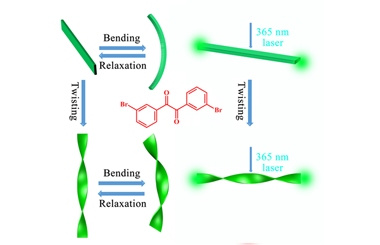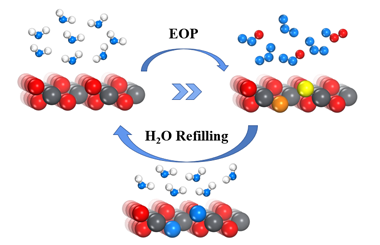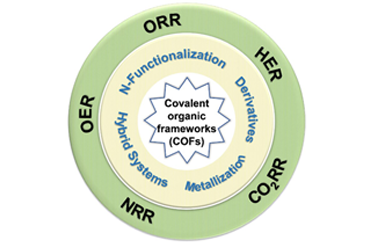
Cover Picture
Ultrathin ZnIn2S4 Nanosheets
Supported Metallic Ni3FeN for Photocatalytic Coupled Selective
Alcohol Oxidation and H2 Evolution
Mengqing Li, Weiliang Qi, Jiuyang Yu, Lijuan Shen, Xuhui Yang, Siqi Liu* and Min-Quan Yang*
Submit a ManuscriptDecember 2022Vol. 41, Issue 12
-
PerspectiveStimuli-Responsive Molecules: Emerging Materials for Advanced Data-Encryption and Anti-Counterfeiting
Xiaocheng Zhang, Xiaolan Yu, Junyi Wu and Weiguo Huang*
Chin. J. Struct. Chem. 2022, 41, 2212001-2212003 DOI: 10.14102/j.cnki.0254-5861.2022-0220
December 2, 2022
stimuli-responsive molecules, dynamic emission, security inks, data protection
ABSTRACT
-
Short Communication
Flexible Organic Single Crystal with Elastic Bending and Plastic Twisting Capabilities
Jiang Peng†*, Wanjun Zhao†, Jing Zhang, Chuchu Han, Junhui Jia, Tingting Feng and Jiawen Sun
Chin. J. Struct. Chem. 2022, 41, 2212004-2212006 DOI: 10.14102/j.cnki.0254-5861.2022-0217
December 2, 2022
flexible crystal, elastic bending, plastic twisting, elastoplastic deformation, waveguide
ABSTRACT
-
Article
Engineering the Interface and Interaction Structure on Highly Coke-Resistant Ni/CeO2-Al2O3 Catalyst for Dry Reforming of Methane
Sha Li, Xin Wang, Min Cao, Jingjun Lu, Li Qiu and Xiaoliang Yan*
Chin. J. Struct. Chem. 2022, 41, 2212007-2212014 DOI: 10.14102/j.cnki.0254-5861.2022-0113
December 2, 2022
metal-support interaction, interface, Ni catalysts, CeO2, dry reforming of methane
ABSTRACT
Designing and tailoring metal-support interaction in Ni-based catalysts with plentiful interfacial sites is of significant interest for achieving a targeted catalytic performance in dry reforming of methane (DRM), but remains as a challenging task. In this work, Ni/Al2O3 and Ni/CeO2-Al2O3 catalysts with the same strong metal-support interaction (SMSI) but distinct interface structure are developed by an improved evaporation-induced self-assembly method using pseudobohemite gel as aluminum source. Ni/CeO2-Al2O3 exhibits superior catalytic activity and stability in DRM in comparison with Ni/Al2O3. The highest CH4 and CO2 conversion reaches at 71.4% and 82.1% for Ni/CeO2-Al2O3, which are higher than that of 64.3% and 75.6% for Ni/Al2O3 at 700 °C. The SMSI effect in Ni/CeO2-Al2O3 provides more active interfacial sites with less coke deposition, and promotes the generation of active formate species which are the key intermediates for DRM. The findings of the present work could possibly pave the way for fabricating catalysts with SMSI strategy for efficient heterogeneous catalysis. -
Article
Ultrathin ZnIn2S4 Nanosheets-Supported Metallic Ni3FeN for Photocatalytic Coupled Selective Alcohol Oxidation and H2 Evolution
Mengqing Li, Weiliang Qi, Jiuyang Yu, Lijuan Shen, Xuhui Yang, Siqi Liu* and Min-Quan Yang*
Chin. J. Struct. Chem. 2022, 41, 2212015-2212024 DOI: 10.14102/j.cnki.0254-5861.2022-0147
December 2, 2022
transition metal nitrides, cocatalyst, ultrathin 2D nanosheets, electrostatic self-assembly, interfacial contact, selective alcohol oxidation, H2 evolution
ABSTRACT
Photocatalytic anaerobic organic oxidation coupled with H2 evolution represents an advanced solar energy utilization strategy for the coproduction of clean fuel and fine chemicals. To achieve a high conversion efficiency, the smart design of efficient catalysts by the right combination of semiconductor light harvesters and cocatalyst is highly required. Herein, we report a composite photocatalyst composed of noble metal-free transition metal nitride Ni3FeN decorated on 2D ultrathin ZnIn2S4 (ZIS) nanosheets for selective oxidation of aromatic alcohols to aldehydes pairing with H2 production. In the composite, ultrathin ZIS serves as a light harvester that greatly shortens the diffusion length of photogenerated charges, while the metallic nitride Ni3FeN acts as an advanced cocatalyst which not only captures the photoelectrons generated from the ultrathin ZIS to promote the charge separation, but also provides active sites to lower the overpotential and accelerate the H2 reduction. The best photocatalytic performance is found on ZIS/1.5% M-Ni3FeN, which shows a H2 generation rate of 2427.9 μmol g-1 h−1 and a benzaldehyde (BAD) production rate of 2460 μmol g-1 h-1, about 7.8-fold as high as that of bare ZIS. This work is anticipated to endorse the exploration of transition metal nitrides as high-performance cocatalysts to promote the coupled photocatalytic organic transformation and H2 production. -
ArticleOne-Pot Synthesis of Bismuth Basic Nitrate-Bi2MoO6 Photocatalyst for Selective Oxidation of Toluene
Tian-Qin Zeng, Lang Chen*, Bing-Hao Wang, Sheng Tian, Zhang-Jun Bai, Xiong Wang, Jun-Kang Guo* and Shuang-Feng Yin*
Chin. J. Struct. Chem. 2022, 41, 2212025-2212032 DOI: 10.14102/j.cnki.0254-5861.2022-0149
December 2, 2022
Bi2MoO6, basic bismuth nitrate, heterojunction, photocatalysis, selective oxidation of toluene
ABSTRACT
The key issues to improve the performance of photocatalysts for selective oxidation of toluene are promoting the migration and separation of charge carrier, and enhancing the generation of active oxygen species. It is known that the construction of compact heterojunction is an efficient protocol to inhibit photogenerated electron-hole recombination. In this work, a 2D-2D [Bi6O6(OH)3](NO3)3·1.5H2O-Bi2MoO6 (denoted as BBN-BMO) composite heterojunction has been prepared by one-step hydrothermal method for the first time. The tetragonal phase BBN in the composite plays the role of transferring electrons from the visible light activated orthorhombic phase BMO and promoting the generation of active •O2-, the holes left in BMO are used to activate toluene and produce benzyl radical, thus greatly improving the photocatalytic performance for selective oxidation of toluene. The toluene conversion rate of BBN-BMO is 3466 μmol·g-1·h-1, which is three times that of pure BMO. The selectivity to benzaldehyde is 94.2%. In addition, reasonable mechanism has been speculated based on a series of control experiments. -
Article
Enhanced Photothermal Selective Conversion of CO2 to CH4 in Water Vapor over Rod-Like Cu and N Co-Doped TiO2
Ji-Chao Wang, Xiu Qiao, Weina Shi*, Huiling Gao*, Lingchen Guo
Chin. J. Struct. Chem. 2022, 41, 2212033-2212042 DOI: 10.14102/j.cnki.0254-5861.2022-0191
December 2, 2022
CO2 conversion, photothermal catalysis, rod-like, TiO2, co-doped
ABSTRACT
Enhancing catalytic efficiency and selectivity is critical issues for CO2 conversion. The rod-like Cu/N co-doped TiO2 samples (Cu/N-TiO2) were synthesized by the electrospinning-calcination method. The substitutional Cu and interstitial N doping not only enhanced visible-light absorption ability, but also formed the Ti(III) sites. The obviously synergistic effect between the photocatalysis and thermalcatalysis appeared for CO2 conversion over the 8-Cu/N-TiO2 catalyst. After 9 h visible-light-illumination at 160 ºC, the CO, CH4 and O2 yields reached 49.7, 1455.1 and 2910.2 μmol/gcat, respectively. In the 7th cycling, the yields of two main CH4 and O2 products were slightly down by less than 11.5%, and the selectivity of CH4 product kept above 98%. Combined with the theoretical surface mode, Cu/N co-doping could promote the adsorption-ability for H2O and CO2 molecules and reduce activation-energy for CO2 conversion. Hence, the co-doping construction showed a great significance of designing efficient photothermal catalysts for the CO2 conversion application. -
Article
Highly Efficient Photocatalytic CO2 Methanation over Ru-Doped TiO2 with Tunable Oxygen Vacancies
Zheyue Li†, Di Wu†, Wanbing Gong*, Jiayi Li, Shuaikang Sang, Hengjie Liu, Ran Long and Yujie Xiong*
Chin. J. Struct. Chem. 2022, 41, 2212043-2212050 DOI: 10.14102/j.cnki.0254-5861.2022-0212
December 2, 2022
photocatalysis, CO2 methanation, metal doping, titanium oxide, oxygen vacancies
ABSTRACT
Solar-driven CO2 methanation is an imperative and promising approach to relieve the global warming and environmental crisis, yet remains a great challenge due to the low reaction efficiency, unsatisfactory selectivity and poor stability. In this work, we demonstrate a facile and efficient strategy to prepare Ru-doped TiO2 photocatalyst with tunable oxygen vacancies using the ascorbic acid as a reducing agent for the CO2 methanation reaction. The optimal Ru-TiO2-OV-50 exhibits a remarkable CH4 production rate of 81.7 mmol g-1 h-1 with a 100% CH4 selectivity under a 1.5 W cm-2 light illumination, which is significantly higher than commercial Ru/TiO2 and other reported catalysts. We reveal that the superior photocatalytic CO2 methanation performance is mainly due to the synergistic effect of Ru doping and TiO2 with tunable oxygen vacancies. Impressively, the light rather than thermal effect is confirmed as the main influencing factor by experimental studies. In addition, in situ spectroscopic technology is performed to investigate the CO2 methanation reaction pathway. This work will open an avenue to design and prepare highly efficient photocatalyst with tunable oxygen vacancies for CO2 conversion and other related applications. -
ReviewThe Structural and Chemical Reactivity of Lattice Oxygens on β-PbO2 EOP Electrocatalysts
Wenwen Li, Ge Feng, Jia Liu, Xing Zhong, Zihao Yao, Shengwei Deng, Shibin Wang* and Jianguo Wang
Chin. J. Struct. Chem. 2022, 41, 2212051-2212059 DOI: 10.14102/j.cnki.0254-5861.2022-0153
December 2, 2022
oxygen vacancy effect, electrochemical ozone production, lattice oxygen mechanism, density functional theory
ABSTRACT
The oxygen evolution reaction (OER) and electrochemical ozone production (EOP) attracted considerable attention due to their wide applications in electrocatalysis, but the detailed reaction mechanism of product formation as well as the voltage effect on O2/O3 formation still remains unclear. In this work, the density functional theory calculations were used to systematically investigate the possible reaction mechanisms of OER and EOP on the PbO2 (110) surface, with the possible reaction network involving surface lattice oxygen atoms (LOM) proposed. The results show that the LOM-2 reaction pathway involving two surface lattice oxygen atoms (Olatt) and one oxygen atom from H2O was the most thermodynamically reactive. Different potential determining step (PDS) was obtained depending on the multiple reaction pathway, and the results show that the facile diffusion of Olatt would proceed the LOM pathway and promote the formation of surface oxygen vacancies (Ovac1/Ovac2). Furthermore, Ovac1/Ovac2 formation on the surface would trigger further reactions of H2O adsorption and splitting, which refilled the oxygen vacancy and ensured the considerable stability of the PbO2 (110) surface. Multiple H2O dissociation pathways were proposed on PbO2 (110) with oxygen vacancy sites: the acid-base interaction mechanism and the vacancy fulfilling mechanism. -
Review
Porous Metal-Organic Framework-Polymer Composites Using High Internal Phase Emulsion Templates: A Review
Yue Qiu, Jin-Jin Li*, Ling Zhao, Zhenhao Xi* and Weikang Yuan
Chin. J. Struct. Chem. 2022, 41, 2212060-2212069 DOI: 10.14102/j.cnki.0254-5861.2022-0179
December 2, 2022
high internal phase emulsion (HIPE), metal-organic frameworks (MOFs), adsorption and separation, heterogeneous catalysis, bioengineering
ABSTRACT
As promising engineering materials for green and sustainable processes, porous metal-organic framework (MOF)-polymer composites show great potential in applications, including adsorption, separation, catalysis, and bioengineering. Owing to the mild and scalable operation, porous polymeric materials derived from high internal phase emulsion templates (polyHIPE) have received great interests in recent decades. In this contribution, research progress of the preparation of porous MOF@polyHIPE composites and their applications are reviewed, highlighting how can MOF particles be shaped by HIPE templates, in particular the polymerizable ones. Four different emulsion templates stabilized by MOFs and the applications of corresponding MOF@polyHIPE are included. Hopefully, both the state-of-art and future directions present herein can give rise to the development of high-performance porous MOF@polyHIPEs. -
ReviewResearch Advances in Helicene Structure-Based Chiral Luminescent Materials and Their Circularly Polarized Electroluminescence
Xu-Feng Luo, Jie He, Yang Wang*, Hong Dai* and Zheng-Guang Wu*
Chin. J. Struct. Chem. 2022, 41, 2212070-2212079 DOI: 10.14102/j.cnki.0254-5861.2022-0196
December 2, 2022
helicene, circularly polarized electroluminescence, circularly polarized luminescence, chiral luminescent material, thermally activated delayed fluorescence
ABSTRACT
Benefited from direct generation of circularly polarized (CP) emission with tunable colors, high efficiencies and facile device architectures, CP organic light-emitting diodes (CP-OLEDs) have attracted great attention and are expected to meet industrial applications. Particularly, CP electroluminescence (CPEL) originated from CP-OLEDs has wide potential applications in 3D displays, optical information storage, quantum communication, and biological sensors. The diverse design strategies of chiral luminescent materials for CP-OLEDs, including small organic emitters, lanthanide and transition-metal complexes and conjugated polymers, have been extensively explored. Helicene with twisted extended π-conjugated molecular structure could exhibit special helical chirality and excellent circularly polarized luminescence properties, which has been employed as the ingenious chirality core for constructing efficient chiral luminescent materials. In addition, significant improvements have been made in terms of CP photoluminescence research, however, the development of CPEL with more application prospects in optoelectronic technology still lags behind. In this review, we systematically summarize the recent advances in chiral luminescent materials based on helicene structure and their CPEL properties, including helicene-based chiral fluorescence molecules, transition metal complexes and thermally activated delayed fluorescence molecules, and discuss current challenges and future perspectives for this hot research field. We believe this progress report will provide a promising perspective of OLEDs based on helicene emitters with CPEL properties for extensive researchers, including chemical, physical and material scientists in different disciplinary fields and attract them to this rapidly developing field.
-
Review
Recent Developments of Dinitrogen Activation on Metal Complexes and Clusters
Xue-Lu Ma, Meng Li, Jun-Bo Lu, Cong-Qiao Xu and Jun Li*
Chin. J. Struct. Chem. 2022, 41, 2212080-2212088 DOI: 10.14102/j.cnki.0254-5861.2022-0197
December 2, 2022
dinitrogen activation, binding mode, dinitrogen complex, metal cluster, synergistic mechanism
ABSTRACT
Dinitrogen (N2) is the major component of the atmosphere and many factors bring about dinitrogen inertness with low reactivity. Dinitrogen activation on metal complexes and clusters under ambient condition is the long-standing goal in the modern chemistry. In this review, an attempt has been made to survey the mechanistic aspects of dinitrogen activation and functionalization based on different coordination binding modes of dinitrogen. Our goal is to provide a comprehensive survey of dinitrogen activation in order to guide the relevant research in the future.
-
Review
Recent Advances of Cu-Based Materials for Electrochemical Nitrate Reduction to Ammonia
Tianlun Ren, Youwei Sheng, Mingzhen Wang, Kaili Ren, Lianlian Wang* and You Xu*
Chin. J. Struct. Chem. 2022, 41, 2212089-2212106 DOI: 10.14102/j.cnki.0254-5861.2022-0201
December 2, 2022
copper, nitrate reduction reaction, ammonia synthesis, electrocatalytic, catalyst design
ABSTRACT
The pollution of nitrate in groundwater has become an environmental problem of general concern due to adverse human and ecological impacts. Treatment of nitrate-rich wastewater is of significance yet challenging for the conventional biological denitrification processes. Electrocatalytic nitrate-to-ammonia conversion emerges as one of the most promising avenues to remove environmentally harmful nitrate from various types of wastewaters while simultaneously producing value-added ammonia. Cu-based materials show great advantages in promoting selective electroreduction of nitrate to ammonia in terms of high nitrate conversion efficiency, ammonia selectivity and ammonia faradaic efficiency thanks to the 3d transition metal structure, low cost, high reserves, and excellent catalytic performance of Cu. In this review, we comprehensively overview the most recent advances in selective electrocatalytic nitrate-to-ammonia conversion using Cu-based materials. Various kinds of Cu-based materials including monometallic Cu catalysts, bimetallic Cu-based catalysts, Cu-based compounds, and Cu-based inorganic-organic hybrid materials and their derivatives are discussed in detail with emphasis on their structural and compositional features and functional mechanisms in promoting nitrate-to-ammonia conversion. Finally, a brief discussion on future directions, challenges and opportunities in this field is also provided. -
Review
Methods to Make Conductive Covalent Organic Frameworks for Electrocatalytic Applications
Mengyang Chen, Ye Zhou, Shi-Bin Ren* and Jiong Wang*
Chin. J. Struct. Chem. 2022, 41, 2212107-2212119 DOI: 10.14102/j.cnki.0254-5861.2022-0214
December 2, 2022
covalent organic frameworks (COFs), electrocatalyst, electrocatalytic reactions, engineering strategies, electrical conductivity
ABSTRACT
Covalent organic frameworks (COFs) represent a new class of crystalline organic polymer materials with the characteristics of high specific surface area, uniform pore distribution, high porosity, low density, devisable chain structures and good structural stability. These collective features play an important role in creating highly efficient electrocatalysts for energy conversion and fuel generation. Recent years have witnessed considerable advances in COF-based electrocatalysts for major electrocatalytic reactions such as oxygen reduction, oxygen evolution, hydrogen evolution, and reduction of carbon dioxide and nitrogen. However, it has been widely accepted that the poor electrical conductivity of most pristine COFs limits the further progress in electrocatalytic field. In this review, recent structural engineering strategies are summarized toward improving the electrical conductivity of COFs for achieving high performance. The researches of conductive COFs and their derivatives are described in detail. The structure-activity relationship between molecular structures of COFs and their electrocatalytic performance is emphasized. Lastly, current challenges and future perspectives on fabricating COFs as promising electrocatalysts are discussed. The purpose of this review is to provide guidelines for the preparation of highly efficient COF-based electrocatalytic materials with a view to replacing the commercially available noble metal-based electrocatalysts.


















